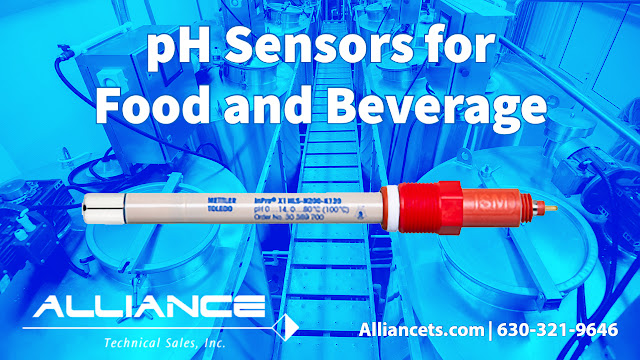pH measurement is essential in the food and beverage industry to ensure food safety, maintain product quality and consistency, optimize taste and flavor, comply with regulations, control chemical reactions, and preserve nutrient content.
The Mettler Toledo InPro X1 HLS pH sensor is designed specifically for Food & Beverage applications. The InPro X1 HLS construction includes high-quality materials that make it highly durable and more applicable than a glass pH sensor.
The InPro X1 HLS:
- Resists Clean-in-Place Processes - The InPro X1 HLS is the premier food-safe, in-line pH sensor, maintaining accuracy and longevity without compromising its ability to withstand cleaning processes.
- Improves Product Yield and Quality - Accurate in-line pH measurement enables absolute process control, resulting in enhanced product quality, increased yield, and reduced batch times.
- Meets All Major Food Regulations - The InPro X1 HLS features a hygienic design, using materials chosen explicitly for food and beverage contact applications, and holds certifications such as 3A, EHEDG, EC1935/2004, ATEX, and FM.
- Eliminates Risk of Glass Contamination - The unbreakable X-Chip pH-sensing technology allows for in-line pH measurement without the hazard of glass fragment contamination.
Why is pH Measurement Critical for the Food and Beverage Processing Industry?
- Food safety and shelf life: pH levels can affect the growth of microorganisms, such as bacteria, yeast, and mold. A lower pH (higher acidity) usually inhibits the growth of harmful organisms, improving food safety and extending shelf life. Measuring and controlling pH can help prevent spoilage and ensure the safety of products.
- Product quality and consistency: pH significantly impacts the taste, texture, and appearance of food and beverages. It can influence enzymatic reactions, protein denaturation, and Maillard browning reactions. Manufacturers can maintain product quality and consistency across different batches by controlling pH.
- Flavor and taste: pH affects the taste profile of food and beverages. For example, acidic products (lower pH) have a sour taste, while basic products (higher pH) tend to taste bitter. Balancing pH is essential to achieving the desired flavor profile and consumer acceptance.
- Regulatory compliance: Food and beverage industries must adhere to strict regulations and guidelines, which often include specific pH requirements. Meeting these regulations ensures that products are safe for consumption and reduces the risk of product recalls.
- Chemical reactions: pH influences the rate and extent of chemical reactions in food and beverage products, such as fermentation, emulsification, and gelation. Manufacturers can optimize these reactions by monitoring and controlling pH to achieve the desired product characteristics.
- Nutrient availability and stability: pH levels can influence the stability and availability of nutrients, such as vitamins and minerals, in food and beverages. Controlling pH can help maintain nutrient content and improve the nutritional value of products.
